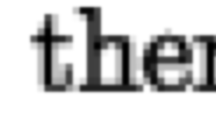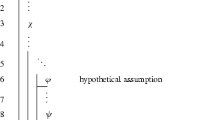Abstract
We present and defend the Australian Plan semantics for negation. This is a comprehensive account, suitable for a variety of different logics. It is based on two ideas. The first is that negation is an exclusion-expressing device: we utter negations to express incompatibilities. The second is that, because incompatibility is modal, negation is a modal operator as well. It can, then, be modelled as a quantifier over points in frames, restricted by accessibility relations representing compatibilities and incompatibilities between such points. We defuse a number of objections to this Plan, raised by supporters of the American Plan for negation, in which negation is handled via a many-valued semantics. We show that the Australian Plan has substantial advantages over the American Plan.
Article PDF
Similar content being viewed by others
Avoid common mistakes on your manuscript.
References
Barwise, J., & Etchemendy, J. (1990). Information, infons, and inference. In Cooper, R., Mukai, K., Perry, J. (Eds.) Situation theory and its applications, (Vol. 1, number 22 pp. 33–78). Stanford.
Barwise, J., & Perry, J. (1983). Situations and attitudes. Bradford books. MIT Press.
Beall, J.C. (2009). Spandrels of truth. Oxford: Oxford University Press.
Beall, J.C., & Restall, G. (2000). Logical pluralism. Australasian Journal of Philosophy, 78, 475–493. http://consequently.org/writing/pluralism.
Beall, JC, & Restall, G. (2006). Logical pluralism. Oxford: Oxford University Press.
Berto, F. (2008). Adynaton and material exclusion. Australasian Journal of Philosophy, 86, 165–90.
Berto, F. (2014). Absolute contradiction, dialetheism, and revenge. Review of Symbolic Logic, 7, 193–207.
Berto, F. (2015). A modality called “negation”. Mind, 124(495), 761–793.
Birkhoff, G., & von Neumann, J. (1936). The logic of quantum mechanics. The Annals of Mathematics, 37(4), 823–843. http://www.jstor.org/stable/1968621.
Brandom, R.B. (1994). Making it explicit. Harvard University Press.
Brandom, R.B. (2000). Articulating reasons: an introduction to inferentialism. Harvard University Press. ISBN 0674001583.
De, M., & Omori, H. (2017). There is more to negation than modality. Journal of Philosophical Logic, 1–19. ISSN 1573-0433, https://doi.org/10.1007/s10992-017-9427-0.
Dunn, J.M., & Zhou, C. (2005). Negation in the context of gaggle theory. Studia Logica, 80, 235–64.
Dunn, J.M. (1993). Partial-gaggles applied to logics with restricted structural rules. In Schroeder-Heister, P., & Došen, K. (Eds.) Substructural logics: Oxford University Press.
Dunn, J.M. (1994). Star and perp: two treatments of negation. In Tomberlin, J.E. (Ed.) Philosophical perspectives. http://www.jstor.org/stable/2214128, (Vol. 7 pp. 331–357). Atascadero: Ridgeview Publishing Company.
Dunn, J.M. (1996). Generalised ortho negation. In Wansing, H. (Ed.) Negation: a notion in focus (pp. 3–26). Berlin: Walter de Gruyter.
Novaes, C.D. (2007). Contradiction: the real philosophical challenge for paraconsistent logic. In Béziau, J.Y., Carnielli, W., Gabbay, D. (Eds.) Handbook of paraconsistency (pp. 477–92). London: College Publications.
Fine, K. (2009). The question of ontology. In Chalmers, D., Manley, D., Wasserman, R. (Eds.) Metametaphysics (pp. 157–77). Clarendon.
Fitting, M. (1991). Bilattices and the semantics of logic programming. ISSN 0743-1066, (Vol. 11 pp. 91–116), DOI https://doi.org/10.1016/0743-1066(91)90014-G, http://www.sciencedirect.com/science/article/pii/074310669190014G.
Goldblatt, R. (1974). Semantic analysis of orthologic. The Journal of Philosophical Logic, 3(1–2), 19–35. https://doi.org/10.1007/BF00652069. Reprinted as Chapter 3 of Mathematics of Modality, Robert Goldblatt. Mathematics of Modality. Number 43 in CSLI Lecture Notes. CSLI Publications, 1993. http://standish.stanford.edu/bin/detail?fileID=458253745.
Grim, P. (2004). What is a contradiction? In Priest, G., Beall, J.C., Armour-Garb, B. (Eds.) The law of non-contradiction (pp. 49–72). Clarendon.
Incurvati, L., & Schlöder, J.J. (2017). Weak rejection. Australasian Journal of Philosophy, 95(4), 741–760. https://doi.org/10.1080/00048402.2016.1277771.
Kripke, S. (1965). Semantical analysis of intuitionistic logic. In Crossley, J., & Dummett, M.A.E. (Eds.) Formal Systems and Recursive Functions (pp. 92–130). Amsterdam: North-Holland Publishing.
Kripke, S. (1980). Naming and necessity. Oxford: Blackwell.
Lewis, D.K. (1973). Counterfactuals. Oxford: Blackwell.
Mares, E.D. (1995). A star-free semantics for R. Journal of Symbolic Logic, 60, 579–590.
Mares, E.D. (2004). Relevant logic. A philosophical interpretation. Cambridge: Cambridge University press.
Meyer, R.K., & Martin, E.P. (1986). Logic on the australian plan. The Journal of Philosophical Logic, 15(3), 305–332. https://doi.org/10.1007/BF00248574.
Price, H. (1990). Why ‘not’? Mind, 99, 221–38.
Priest, G. (2008). An introduction to non-classical logic, 2nd edn. Vol. 2008. Cambridge: Cambridge University Press.
Restall, G. (1993). Four-valued semantics for relevant logics (and some of their rivals). Journal of Philosophical Logic, 24, 139–69.
Restall, G. (1995). Information flow and relevant logics. In Seligman, J., & Westerståhl, D. (Eds.) Logic, language and computation: the 1994 Moraga proceedings (pp. 463–477).
Restall, G. (1999). Negation in relevant logics (how i stopped worrying and learned to love the Routley star). In Gabbay, D., & Wansing, H. (Eds.) What is negation? (pp. 53–76). Dordrecht: Kluwer.
Restall, G. (2000). An introduction to substructural logics. Routledge.
Restall, G. (2000). Defining double negation elimination. The Logic Journal of the IGPL, 8(6), 853–860. http://jigpal.oxfordjournals.org/cgi/content/abstract/8/6/853.
Restall, G. (2005). Multiple conclusions. In Hájek, P., Valdés-Villanueva, L., Westerståhl, D. (Eds.) Logic, methodology and philosophy of science: proceedings of the twelfth international congress (pp. 189–205): KCL Publications. http://consequently.org/writing/multipleconclusions.
Restall, G. (2009). Truth values and proof theory. Studia Logica, 92(2), 241–264. http://consequently.org/writing/tvpt/.
Ripley, D. (2013). Paradoxes and failures of cut. Australasian Journal of Philosophy, 91(1), 139–164. https://doi.org/10.1080/00048402.2011.630010.
Routley, R., & Meyer, R.K. (1972). The semantics of entailment II. Journal of Philosophical Logic, 1, 53–73.
Routley, R., & Meyer, R.K. (1973). The semantics of entailment I. In Leblanc, H. (Ed.) Truth, syntax, and semantics (pp. 194–243). North-Holland.
Routley, R. (1984). The American plan completed: alternative classical-style semantics, without stars, for relevant and paraconsistent logics. Studia Logica, 43(1–2), 131–158. https://doi.org/10.1007/BF00935746.
Routley, R., & Routley, V. (1972). Semantics of first degree entailment. Noûs, 6(4), 335–359. http://www.jstor.org/stable/2214309.
Stalnaker, R. (1968). A theory of conditionals. In Rescher, N. (Ed.) Studies in logical theory (pp. 98–112). Oxford: Blackwell.
Tahko, T. (2009). The law of non-contradiction as a metaphysical principle. Australasian Journal of Logic, 7, 32–47.
Tennant, N. (1999). Negation, absurdity and contrariety. In Gabbay, D., & Wansing, H. (Eds.) What Is negation? (pp. 199–222). Dordrecht: Kluwer.
Tye, M. (1990). Vague objects. Mind, XCIX(396), 535. https://doi.org/10.1093/mind/XCIX.396.535.
Wansing, H. (2001). Negation. In Goble, L. (Ed.) The Blackwell guide to philosophical logic (pp. 415–36). Oxford: Blackwell.
Wansing, H. (2008). Constructive negation, implication, and co-implication. Journal of Applied Non-Classical Logics, 18(2-3), 341–364.
Wiggins, D. (2001). Sameness and substance renewed. Cambridge: Cambridge University Press.
Author information
Authors and Affiliations
Corresponding author
Additional information
Publisher’s Note
Springer Nature remains neutral with regard to jurisdictional claims in published maps and institutional affiliations.
Rights and permissions
Open Access This article is distributed under the terms of the Creative Commons Attribution 4.0 International License (http://creativecommons.org/licenses/by/4.0/), which permits unrestricted use, distribution, and reproduction in any medium, provided you give appropriate credit to the original author(s) and the source, provide a link to the Creative Commons license, and indicate if changes were made.
About this article
Cite this article
Berto, F., Restall, G. Negation on the Australian Plan. J Philos Logic 48, 1119–1144 (2019). https://doi.org/10.1007/s10992-019-09510-2
Received:
Accepted:
Published:
Issue Date:
DOI: https://doi.org/10.1007/s10992-019-09510-2




